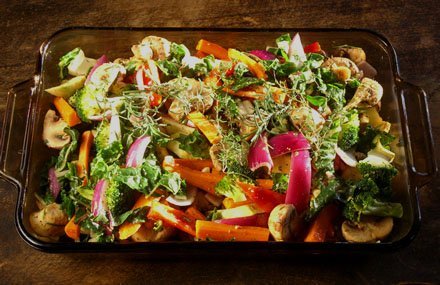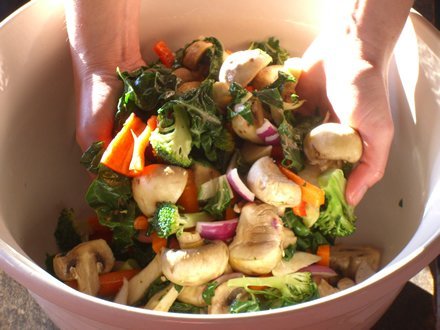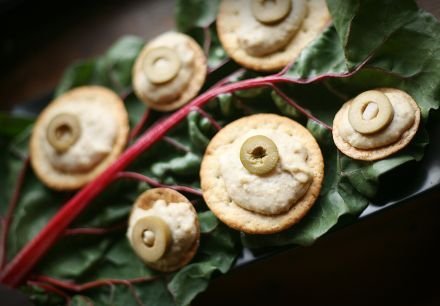The New Year’s Resolution Roast

(Vegetarian, vegan, gluten-free)
It’s possible that my sister-in-law won’t eat my cooking again. During the holiday season several of the women in my family gathered in my kitchen for a cookie-making marathon. And indeed it was; we whipped up chocolate mousse bites, Russian wedding cakes, cinnamon chip, ginger biscotti, peanut butter bars, and yes, cornflake wreaths (my sister’s specialty).
At one point during the clattering of pans, the roar of mixers and the raucous laughter, I realized that my sister-in-law was staring at me, aghast. I followed Heather’s gaze, which was settled upon my hands. Except that you couldn’t actually see my hands, submerged as they were in a dense, allspice-scented batter. I was working the hazelnuts into the dough. I gave Heather an inquisitive look, and she shrugged and turned back to her own wooden-spoon combined pastry. Later, I grabbed a handful of cake flour from the canister, unwittingly letting some fall through my fingers as I went to sprinkle it into my wet dough. Again, Heather caught me. This time I shrugged.
That’s how I operate in the kitchen. Intuitively, assertively, almost impulsively, smelling my way through things, using my eyes as a scale, my ears as an assessment of doneness. And unfailingly and unapologetically, using my hands as kitchen utensils. I’ve been noticing lately that this startles people. But why? My hands work better than any kitchen tool, and they’re always, well, on hand, and if I’m cooking then I’ve washed them first and I’m touching the food regardless so… what’s the big deal? And anyway, I’ve seen Jamie Oliver do it, so maybe I should just adopt some British-isms and then it will all be pukka.
Here’s a recipe that will give the fingers a workout. It isn’t a bean recipe. Heck, it’s barely a recipe at all. Now and then I’ll toss some non-legume foods into the mix, because the Year of the Bean Alone would be one long year. What this dish really is is my New Year’s resolution on a plate.
Simon and I are guilty of letting beautiful produce go to waste (and since I do 3/4ths of the cooking, that really means me). It’s not that we don’t eat it. It is, rather, that at markets and grocery stores I get kind of giddy when I see all those shiny peppers and happy tomatoes and multi-colored Swiss Chard stems. Though we entertain a lot, day to day it’s just Simon and me, and we end up composting an embarrassing amount of food (although, oddly, the cats love Brussels sprouts and edamame, so those never go to waste).
It’s no consolation to me to know that I’m not alone. Here’s a fact that left me bloody gobsmacked: According to a 2002 University of Arizona study, the average family throws away 470 pounds of food every year. That’s 14% of food brought into the home, worth roughly $650. There are actually a number of new food-storage technologies on the market to help slow food decay (if you’re interested in what I found, see the end of this post), but I’ve vowed that this year I’ll eat them while they’re fresh.

The Recipe:
Twelve days into the year and I was staring at a drawer full of veggies on the edge. Here’s a recipe for when you find yourself in the same straits.
1. Wash your hands. I mean scrub them. People are going to eat this stuff, after all.
2. Preheat your oven to 400.
3. Gather up all the veggies that are looking short for this world. Wash and then peel/core/chop them, and scrape them into a big bowl.
4. Gleefully using your very own fingers, toss the veggies.
5. In another bowl, combine enough olive oil to coat your veggies, some chopped garlic, a squeeze or two of spicy mustard if that appeals to you, salt, pepper, and a generous dash of vinegar. Also throw in whatever herbs smell good in the moment. For this batch, I used oregano, thyme, Fines herbs and a dash of tarragon. Mix well (use a spoon or a small whisk for this part — I did!) and then pour it over your veggies.
6. Get your hands ready. You’ll need them to toss the veggies again, making sure they’re coated with the oil/vinegar mixture.
7. Dump them into a baking dish.
8. If you are lucky enough to have fresh herbs growing inside, snip a sprig or two and throw it on top. I have rosemary and thyme, so that’s what I used.
9. Stick it in the oven and let it roast till veggies are tender but not mushy. The length of time will depend on what kind of veggies you used and how big you chopped them.
10. Using your hands (but wearing an oven mitt!), remove veggies from the oven while they’re sizzling, steaming and letting off a pungent aroma. Lovely jubbly!
Still, if you just can’t eat them fast enough, there are some new gadgets out there to help. I’ll probably mention this again at Easter, because it’s a perfect gift. It was around Easter last year that I discovered the E.G.G, or the Ethylene Gas Guardian. About the size and shape of an egg, and available in pastel shades like pink and yellow, these little guys get dropped into the crisper drawer and absorb up to 97 % of the ethylene, the gas that’s primarily responsible for produce decay. Other products that absorb ethylene are the ExtraLife disk and BioFresh produce bags. In my experience, the E.G.G.s work best though.
And of course if you do let fruits and veggies go bad, compost them!


